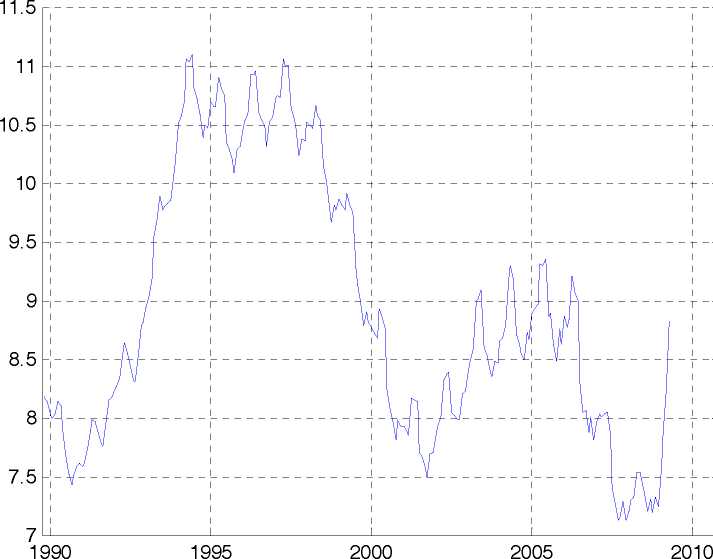This might reflect declining inflation expectations in response to the adoption of a
single monetary policy pursuing long-term price stability, as specified in the
Maastricht Treaty. As the Bundesbank (2009) points out, all surveys for medium- to
long-term inflation expectations in the euro area have indicated a rate just under 2%
since the euro was launched in January 1999. This suggests that the Eurosystem was
successful in creating and maintaining credibility, convincing individuals and
enterprises that resolute action in terms of interest rates would be taken in the
presence of serious inflationary risks.
Chart 2. EMU Unemployment rate

VAL.EZ.CURRENT.UNEM.TOT.M_PC_UNEM_TOT.NSA. It is linked backwards until February
1982 with the series “EU12 including West Germany - Standardised unemployment rate, Total (all
ages), Total (male & female), Eurostat, neither seasonally nor working day adjusted, percentage of
civilian workforce”, Eurostat code: VAL.UNER.T.A0_99.ORIGINAL.EC_85.M. The two remaining
years are completed by using the yearly growth rate of the series “Euro area - UNEMPLOYMENT,
STANDARDISED (EU/ILO DEFINITION)(MU16) SA”, from the BIS database: Macro-economic
series (Blocks A-K, Q-W).
More intriguing information
1. The name is absent2. Linking Indigenous Social Capital to a Global Economy
3. The name is absent
4. Correlation Analysis of Financial Contagion: What One Should Know Before Running a Test
5. AN IMPROVED 2D OPTICAL FLOW SENSOR FOR MOTION SEGMENTATION
6. Public infrastructure capital, scale economies and returns to variety
7. Does Market Concentration Promote or Reduce New Product Introductions? Evidence from US Food Industry
8. PEER-REVIEWED FINAL EDITED VERSION OF ARTICLE PRIOR TO PUBLICATION
9. The name is absent
10. Notes on an Endogenous Growth Model with two Capital Stocks II: The Stochastic Case